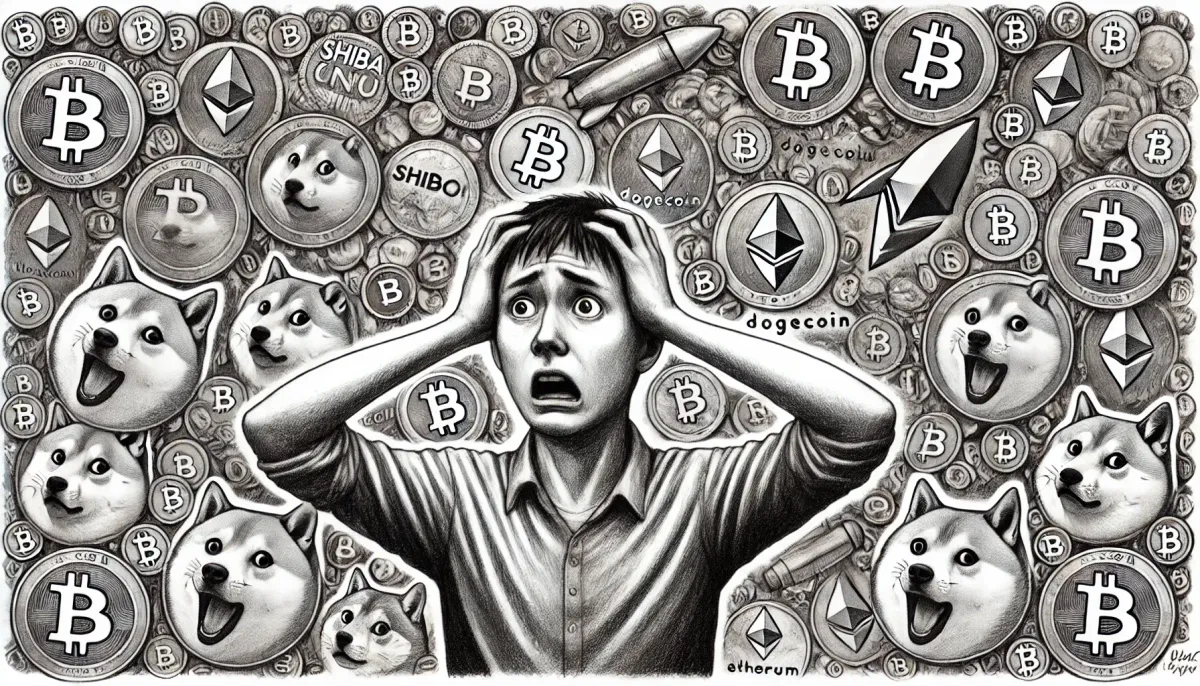Meme coins have captivated millions, attracting investors who, despite high risks and expert warnings, are drawn to the promise of quick wealth. This phenomenon goes beyond finance; it's deeply social and psychological. Understanding why people invest in these often “worthless” assets requires examining the motivations—emotional impulses, social dynamics, demographic trends, and speculative goals—that drive them to take such risks. Let’s unpack these forces to explore the unique allure of meme coins.
1. Emotional Drivers
Fear of Missing Out (FOMO): The Urgency of Opportunity
A dominant force in meme coin investing is the Fear of Missing Out (FOMO). A recent study highlights that nearly 70% of meme coin investors cite FOMO as their main reason for buying in, particularly when faced with stories of soaring values and quick profits. In the investment world, FOMO has a unique intensity with meme coins; their rapid price surges are highly visible, creating a sense of “catch it now, or miss it forever.” This urgency is amplified by social media, where viral posts of skyrocketing values circulate widely, tempting people to join in before it’s “too late.”
The effect of FOMO on meme coin investments becomes self-reinforcing: viral posts lead to more buyers, which pushes prices up, which creates more FOMO—and the cycle continues. In fact, studies show that half of meme coin purchases happen immediately after a surge in social media activity around a coin, revealing just how tightly linked social influence and FOMO are in this sphere.
The Gambling Mentality: A Psychological Thrill
Many meme coin investors admit to approaching these investments with a thrill-seeking mentality. Research shows that over 40% of meme coin investors liken it to gambling, driven by the high-risk, high-reward potential that makes each investment feel like a lottery ticket. For these investors, the stakes are often small—average investments range from $100 to $500—but the perceived potential for exponential returns is what keeps them coming back.
This type of behavior aligns with what psychologists refer to as “intermittent reward,” where unpredictable outcomes trigger a rush of dopamine, creating an addictive effect similar to gambling. This mindset fuels the allure of meme coins, where each new investment represents another chance at a big win, despite the odds. By entering the meme coin arena, investors are essentially buying into a cycle of adrenaline and anticipation, hoping for that one significant, life-changing payout.
2. Social Dynamics
Social Proof & Herd Behavior: Following the Crowd
Social proof—the tendency to follow others’ actions when we’re uncertain—is a powerful motivator in meme coin investing. Approximately 86% of meme coin investors report that their decisions are influenced by friends, family, or online communities, where other investors’ successes provide a sense of validation. This group behavior is particularly strong on social platforms like Twitter, Reddit, and Telegram, where communities rally around tokens, creating an atmosphere of excitement and shared purpose.
This is why platforms like Reddit’s WallStreetBets have become central hubs for meme coin enthusiasm. The collective energy of thousands of people discussing potential gains builds a sense of credibility around coins that may otherwise be seen as baseless. Herd behavior then takes over, as more investors join to avoid being left out of potential gains, reinforcing the coin’s value through sheer volume of participation.
A Sense of Belonging: Investing for Identity and Community
For many meme coin investors, the appeal extends beyond financial gain. Meme coins often come with their own communities, where users feel a sense of belonging and shared identity. These communities are rooted in collective enthusiasm, humor, and a shared goal of proving skeptics wrong. Unlike traditional financial markets, where individuality and analysis often prevail, meme coin investors rally together, sometimes even prioritizing community loyalty over rational financial assessments.
The social bonds within these groups drive prices through collective “holding,” where members encourage each other to retain their coins despite potential losses. This camaraderie can be a powerful motivator. As one investor put it, “It’s like being part of an inside joke that just might make you rich.” The emotional value of this connection has become one of the strongest drivers behind meme coin investing, where community is often as valuable as financial gain.
3. Demographic Trends
A Youth-Driven Phenomenon: Young, Bold, and Digitally Savvy
It’s no surprise that meme coins have particularly high appeal among younger demographics. A survey by Finder found that 60% of meme coin investors are between the ages of 18 and 35, an age group with greater comfort around technology, social media, and online financial transactions. Younger investors also tend to have a higher tolerance for risk and a stronger appetite for experimentation, making them more likely to engage with high-volatility assets like meme coins.
This trend highlights a shift in how younger generations approach wealth-building: rather than pursuing gradual, stable growth, they’re drawn to fast, high-potential gains that feel accessible and relatable. For many, meme coins represent the democratization of finance—a chance to play in the same field as larger investors without needing substantial starting capital or financial experience.
Entry-Level Investing: Financial Novices Drawn by Low Costs
Meme coins are particularly attractive to first-time investors; approximately 45% of meme coin investors have little to no experience with traditional finance. This demographic often finds traditional markets intimidating or exclusive, while meme coins, with their low entry costs and high potential upside, feel more approachable. Low costs mean people can experiment with smaller amounts, a factor that has led to widespread participation among those new to investing.
However, limited financial knowledge can make these investors vulnerable to hype-driven decisions. For instance, many newer investors lack the skills to analyze market fundamentals, making them more susceptible to FOMO and social proof. For these individuals, meme coins represent an easy entry into investing, even if that entry is laden with risks.
4. Financial Goals & Attitudes
Speculative Approach: Betting Big on “Quick Wins”
Most meme coin investors adopt a highly speculative approach, seeing meme coins as a shortcut to wealth rather than a long-term investment. Data shows that the average investment per individual is typically under $500, with investors motivated by the potential for rapid gains rather than a steady return. This speculative mentality aligns with a “get rich quick” ethos, where the goal is to catch a coin at its peak hype, then cash out with substantial returns.
The short-term focus of meme coin investors contrasts sharply with traditional investing philosophies, where long-term growth and stability are valued. Meme coin investing is characterized by rapid entry and exit points, a strategy that amplifies volatility and drives demand surges that can create momentary “wealth” for those who enter and exit at the right time.
The Appeal of Rapid Returns: Instant Gratification Over Long-Term Growth
Patience is rarely a virtue for meme coin investors. Many are drawn by the potential for instant results, as meme coins can deliver sharp, sudden increases in value that feel like “winning” in real-time. Traditional investments often require years of steady growth, but meme coins promise a chance for instant financial gratification. This appeals particularly to those who may be disillusioned with gradual wealth-building, especially younger investors who may feel economically disadvantaged in conventional avenues for wealth accumulation.
A recent study highlighted this preference for rapid returns, noting that meme coin investors are three times more likely than stock investors to seek “quick wins” over stable growth. This preference for instant gratification is not merely about financial gain; it’s a reflection of broader generational shifts where quick access to information, entertainment, and now wealth has created a demand for immediacy in all aspects of life.
5. Psychological Anchors in Price and Perception
The Influence of Viral Marketing: “If It’s Popular, It’s Valuable”
In the world of meme coins, marketing can make or break a coin. The impact of social influencers, celebrities, and viral marketing campaigns can be huge, with studies revealing that influencer promotions increase meme coin interest by 30-40%. When a coin is endorsed by a well-known personality, it creates a perception of value, even when there’s no underlying utility or project. This psychological phenomenon—known as “anchoring bias”—leads investors to link popularity with worth, making them more likely to buy in when they see a coin trending.
Familiarity Breeds Comfort: Humor and Relatability as Entry Points
Meme coins use humor and relatable branding to draw in investors. The playful nature of these coins—often linked to familiar internet memes—creates an inviting atmosphere for first-time investors. Instead of feeling intimidating, meme coins feel friendly and accessible, making them a comfortable starting point for those who might otherwise shy away from financial markets. The humor and lighthearted tone provide a psychological comfort that encourages people to invest without fear, reinforcing the idea that meme coins are just “fun” money, even if they’re still very much a financial risk.
Conclusion: A Shariah Perspective on Meme Coin Investing
From an Islamic perspective, meme coin investing introduces complex questions about intention, risk, and value creation. According to Shariah principles, investments should have a basis in tangible value or productive enterprise, aligning with the concept of "Tijarah" (trade). Meme coins, however, often lack intrinsic value, functioning primarily as speculative assets driven by social sentiment and hype. This emphasis on speculation aligns closely with gharar (excessive uncertainty) and maisir (gambling), both of which are generally discouraged in Islamic finance.
For those considering meme coin investments from a Shariah-compliant perspective, it is essential to evaluate the asset’s underlying value and whether it contributes to productive economic activity. To delve deeper into the halal or haram nature of meme coins and understand the ethical implications, explore our comprehensive article on the topic: Are Meme Coins Halal or Haram?. This analysis provides guidance for aligning one’s financial goals with Shariah principles, emphasizing that wealth-building should foster growth not only for the individual but also for the community and economy at large.


